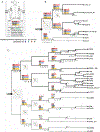Early developmental asymmetries in cell lineage trees in living individuals
- PMID: 33737484
- PMCID: PMC8324008
- DOI: 10.1126/science.abe0981
Early developmental asymmetries in cell lineage trees in living individuals
Abstract
Mosaic mutations can be used to track cell lineages in humans. We used cell cloning to analyze embryonic cell lineages in two living individuals and a postmortem human specimen. Of 10 reconstructed postzygotic divisions, none resulted in balanced contributions of daughter lineages to tissues. In both living individuals, one of two lineages from the first cleavage was dominant across tissues, with 90% frequency in blood. We propose that the efficiency of DNA repair contributes to lineage imbalance. Allocation of lineages in postmortem brain correlated with anterior-posterior axis, associating lineage history with cell fate choices in embryos. We establish a minimally invasive framework for defining cell lineages in any living individual, which paves the way for studying their relevance in health and disease.
Copyright © 2021 The Authors, some rights reserved; exclusive licensee American Association for the Advancement of Science. No claim to original U.S. Government Works.
Conflict of interest statement
Figures



Comment in
-
Human cell-lineage imbalances.Nat Rev Genet. 2021 May;22(5):266-267. doi: 10.1038/s41576-021-00358-4. Nat Rev Genet. 2021. PMID: 33785896 No abstract available.
References
-
- Weinberger DR, Luchins DJ, Morihisa J, Wyatt RJ, Asymmetrical volumes of the right and left frontal and occipital regions of the human brain. Ann Neurol 11, 97–100 (1982). - PubMed
-
- Ellegren H, Microsatellite mutations in the germline: implications for evolutionary inference. Trends Genet 16, 551–558 (2000). - PubMed
Publication types
MeSH terms
Grants and funding
LinkOut - more resources
Full Text Sources
Other Literature Sources

